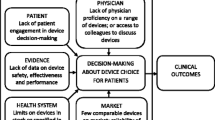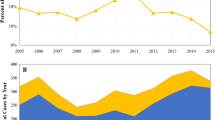Abstract
This paper analyzes a sample interventional cardiologist’s demographic, academic, and professional characteristics to provide an understanding of their technological device adoption styles. The study sample consisted of 15 physicians from two large Midwestern hospitals, one an academic medical center and the other a medium-sized community hospital. Interventional cardiologists were identified through their online physician profile and respective departments. A questionnaire was developed to assess each physician’s self-perceived adoption style, their awareness of the new technology, their participation in clinical trials, organizational support, and how various factors influence their adoption of new technology. Lastly, a database of bare metal and drug eluting stents was examined to document the number of stents used by each physician. Pragmatic and observational findings are presented from the questionnaire, physician profile, to database on stent use. The paper concludes with a discussion of the managerial and forecasting implications and methods to promote technology adoption.
Similar content being viewed by others
References
Oleske, D., Epidemiology and the Delivery of Health Care Services: Methods and Applications, Plenum, New York, p. 401.
Huckman, R. S., and Pisano, G., Turf battles in coronary revascularization. N. Engl. J. Med. 9:857–859, 2005.
Bhatia, V., Bhatia, R., and Dhindsa, M., Drug-eluting stents: New era and new concerns. Postgrad. Med. J. 80:13–19, 2004.
Finarelli, Jr., and Hugo, J., Could your financial health be heading for heart break? Costly drug-eluting stents could dramatically alter projected demands for cardiac surgical services. Healthc. Financ. Manage. 57:68–73, 2003.
Kuntz, R., and Baim, D., Defining coronary restenosis: Newer clinical and angiographic paradigms. Circulation 88:1310–1323, 1993.
Cummings, J., Technology Report: Drug Eluting Stents, University HealthSystem Consortium, 2002.
Dobesh, P. P., Stacy, Z. A., Ansara, A. J., and Enders, J. M., Drug-eluting stents: A mechanical and pharmacological approach to coronary artery disease. Pharmacotherapy 24:1554–1577, 2004.
van der Hoeven, B., Pires, N., Warda, H., Oemrawsingh, P., and Jukema, J., Drug Eluting Stents: Results, Promises, and Problems, Elsevier Ireland, 2004.
Colombo, A., and Iakovou, I., Drug eluting stents: The new gold standard for percutaneous coronary revascularization. Eur. Heart J. 25(6):895, 2004.
Stanik-Hutt, J., Drug-coated stents: Preventing restenosis in coronary artery disease. J. Cardiovasc. Nurs. 19:404–408, 2004.
Hout, B., Serruys, P., and Lemos, P., One-year cost effectiveness of sirolimus eluting stents compared with bare metal stents in the treatment of single native de novo coronary lesions: An analysis from the RAVEL trial. Heart 91:507–512, 2005.
Weintraub, W. S., Economics of sirolimus-eluting stents: Drug eluting stents have really arrived. Am. Heart Assoc. 110:472–474, 2004.
Conti, C. R., Drug eluting stents versus bare metal stents. Clin. Cardiol. 26:493–494, 2003.
Anonymous, Drug eluting stents: Researchers measure healthcare costs of restenosis. Cardiovasc. Watch 4–5, 2004.
Baim, D., New devices for percutaneous coronary intervention are rapidly making bypass surgery obsolete. Curr. Opin. Cardiol. 19:593–597, 2004.
Anonymous, Coronary Revascularization: Impact of Drug-Eluting Stents (DES) SG2, 2004.
Moore, G., Crossing the Chasm, HarperCollins, New York, p. 256.
Stephenson, G., The somewhat flawed theoretical foundation of the extension service. J. Extension 41, 2003.
Stavins, J., Effect of consumer characteristics on the use of payment instruments. N. Engl. Econ. Rev. 19–32, 2001.
Glass, H. E., and Rosenthal, B., Demographics, practices, and prescribing characteristics of physicians who are early adopters of new drugs. PT 29:699–708, 2004.
Escarce, J., Externalities in hospitals and physician adoption of a new surgical technology: An exploratory analysis. J. Health Econ. 15:715–734, 1996.
Edlefsen, K. L., Mandelson, M. T., McIntosh M. W., Andersen, R., Wagner, E. H., and Urban, N., Prostate-specific antigen for prostate cancer screening: Do physician characteristics affect its use? Am. J. Prev. Med. 17:87–90, 1999.
Gunn, J., Morton, A. C., Wales, C., Newman, C. M. H., Crossman, D. C., and Cumberland, D. C., Drug eluting stents: Maximizing benefit and minimizing cost. Heart 89:127–138.
Author information
Authors and Affiliations
Corresponding author
Rights and permissions
About this article
Cite this article
Artis, L.C., Burkhart, T.M., Johnson, T.J. et al. Physician Factors as an Indicator of Technological Device Adoption. J Med Syst 30, 177–186 (2006). https://doi.org/10.1007/s10916-005-8066-2
Received:
Accepted:
Issue Date:
DOI: https://doi.org/10.1007/s10916-005-8066-2




